Linear Tapered Slot Antenna for Ultra-Wideband Radar Sensor: Design Consideration and Recommendation
Abstract
:1. Introduction
- Being unidirectional,
- Involving only one segment—slot,
- Having no curvatures or angles, or only simple ones,
- Able to change half-power beamwidth (HPBW) by changing the slot length, unlike other antennas which require a complete redesign, and
- Integrating easily with a monolithic microwave integrated circuit (MMIC), making it well suited for antenna array implementation [11].
2. Methods
- Slot width (),
- Microstrip width (),
- Slot stub radius (),
- Microstrip stub radius (),
- Slot opening width (),
- Tapered length (),
- Ground width (),
- Ground length (),
- Substrate thickness (), and
- Substrate material.
2.1. Baseline Model
2.2. Software Tools
2.3. Assessment Criteria
- S11 indicates the power loss caused by the antenna, with less loss being better; −10 dB is a desirable value because it means only 10% of power is lost [8,9,10]. In this study, −9.25 dB (11.89% power loss) was aimed for to leave room for multiple parameter adjustments. Therefore, the potential S11 improvement of the baseline model was 0.75 dB.
- Far field radiation pattern on the E-plane (“E-plane”) is composed of the main lobe and multiple side lobes. Four important measurements were conducted on the pattern in this study: the measurement of HPBW, gain, side lobe level, and cross polarization discrimination (XPD).
- -
- HPBW is the degree between two half-power points of the main lobe.
- -
- Gain is the maximum antenna gain.
- -
- Side lobe level is defined as the difference in decibels between the main beam peak value and the side lobe peak value. The peak can occur at the same side as the main lobe (front) or at the opposite side (back). For this study, the front was of greater interest because it was the direction in which the object faced. The desirable front side lobe level (FSLL) was greater than 11.5 dB in order to achieve 70% beam efficiency [8,11].
- -
- XPD is defined as a ratio of the copolar component of the specified polarization compared to the orthogonal cross-polar component over the beamwidth angle [23]. The angles that were examined were 70°, 90°, and 110°. The 90° angle was the on-axial (Y-axis) direction, and the 70° and 110° angles were the general position where the HPBW was located.
- Far field radiation pattern on the H-plane (“H-plane”) is also composed of the main lobe and multiple side lobes. Its HPBW, gain, and FSLL are of the same importance as those in the E-plane, and the preferred FSLL was also desired to be greater than 11.5 dB to achieve 70% beam efficiency.
3. Analysis
3.1. Slot Width () and Microstrip Width ()
- Varying and only, the improvement to S11 could not meet the assessment S11 criterion,
- The lowest S11 peak always occurred at = 100 Ω, and
- Lowering would lower the S11 peak value.
3.2. Slot Stub Radius () and Microstrip Stub Radius ()
3.3. Slot Opening Width ()
- Changing alone will not satisfy the S11 assessment criterion,
- Increasing will decrease the peak S11 values within ultra band range,
- Increasing will increase antenna gain,
- has to be between 19 and 70 mm to satisfy the E-plane and H-plane FSLL assessment criteria. Therefore, it is safe to assumebecause using instead of resulted in = 19.91 mm, which coincided with the simulation results. Meanwhile, was changed toandwhich corresponded to 63.01 and 69.62 mm (~70 mm), respectively, and
- Changing has some but no significant impact on XPD.
3.4. Tapered Length ()
3.5. Ground Width () and Ground Length ()
- Increasing will decrease overshoot in both low and ultra bands, with higher reduction in low bands, and
- variation has little impact on H-plane, E-plane HPBW, gain, or XPD.
- Increasing will decrease the S11 peak in high and ultra bands,
- When or , it will meet the S11 criterion, and
- Variation of has little impact on E-plane, H-plane, or XPD (not shown).
3.6. Substrate Thickness ()
- Increasing the thickness causes a slight gain variation (1.5 dB),
- FSLL will fall below −11.5 dB when ,
- impact on S11 is less prominent but generally follows the same trend as the E-plane,
- has little impact on the H-plane, and
- Increasing reduces XPD on all three angles.
3.7. Substrate Material
4. Results and Discussions
- Lowest S11 peak always occurs at = 100 Ω,
- Lowering would lower S11 peak value,
- Slot stub radius () should be less than ,
- Microstrip stud radius () should be less than ,
- Slot opening width () should be between and ,
- Tapered Length () should be between and ,
- Ground width () should be between and ,
- Ground Length () has to be between and , or greater or equal to ,
- The effective substrate thickness () should be <0.052, and
- Substrate materials have little impact on LTSA performance as long as the same thickness is maintained.
5. Conclusions
Author Contributions
Funding
Conflicts of Interest
References
- Tseng, V.; Chang, C. UWB Radar System for Fall Detection. In Proceedings of the ELTICOM 2016, Taoyuan City, Taiwan, 29–30 August 2016; pp. 1–2. [Google Scholar]
- Adib, F.; Kabelac, Z.; Katabi, D.; Miller, R.C. 3D Tracking via Body Radio Reflections. In Proceedings of the 11th USENIX Symposium on Networked System Design and Implementation, Seattle, WA, USA, 2–4 April 2014; pp. 317–329. [Google Scholar]
- Federal Communications Commission. First Report and Order 02-048; Washington, DC, USA, 2002. Available online: https://transition.fcc.gov/Bureaus/Engineering_Technology/Orders/2002/fcc02048.pdf (accessed on 9 March 2019).
- Meena, M.L.; Kumar, M.; Parmar, G.; Meena, R.S. Design Analysis and Modeling of Directeional UWB Antenna with Elliptical Slotted Ground Structure for Applications in C- & X-Bands. Prog. Electromagn. Res. 2016, 63, 193–207. [Google Scholar]
- Liang, J.; Chiau, C.C.; Chen, X.; Parini, C.G. Study of a printed circular disc monopole antenna for UWB systems. IEEE Trans. Antennas Propag. 2005, 53, 3500–3504. [Google Scholar] [CrossRef]
- Locatelli, A.; Modotto, D.; Pigozzo, F.M.; Boscolo, S.; Autizi, E.; de Angelis, C.; Capobianco, A.-D.; Midrio, M. Highly directional planar ultra wide band antenna for radar applications. In Proceedings of the 2nd European Microwave Integrated Circuits Conference, Munich, Germany, 8–10 October 2007; pp. 623–626. [Google Scholar]
- Mokhtaari, M.; Bornemann, J. Directional ultra-wideband antennas in planar technologies. In Proceedings of the 38th European Microwave Conference, Amsterdam, The Netherlands, 27–31 October 2008; pp. 885–888. [Google Scholar]
- Yngvesson, K.S.; Schaubert, D.H.; Korzeniowski, T.L.; Kollberg, E.L.; Thungren, T.; Lohansson, J.F. Endfire Tapered Slot Antennas on Dielectric Substrates. IEEE Trans. Antennas Propag. 1985, 33, 1392–1400. [Google Scholar]
- Bandlamudi, S.; Mishra, P.; Kumar, S.; Renuka, H.; Kumar, S.; Hariharan, V. Compact Ultra Wide Band Sinuous Antenna. In Proceedings of the 2017 IEEE International Conference on Antenna Innovations & Modern Technologies for Ground, Aircraft and Satellite Applications, Bangalore, India, 24–26 November 2017; pp. 1–6. [Google Scholar]
- Wan, K.; Xie, C.; Zheng, Y.; Yin, J.; Yang, J. A Multilayer-stacked UWB Yagi Antenna. In Proceedings of the 2017 International Symposium on Antennas and Propagation (ISAP), Phuket, Thailand, 30 October–2 November 2017; pp. 1–2. [Google Scholar]
- Yngvesson, K.S.; Korzeniowski, T.L.; Kim, Y.-S. The tapered slot antenna-a new integrated element for millimeter-wave applications. IEEE Trans. Microw. Theory Tech. 1989, 37, 365–374. [Google Scholar] [CrossRef]
- Osama, D.; Abouelnaga, T.; Mohra, A.; El-Hennawy, H. A Novel UWB Vivaldi Antenna Array for Radar Applications. Int. J. Sci. Eng. Res. 2016, 7, 1169–1174. [Google Scholar]
- Moosazadeh, M.; Kharkovsky, S.; Esmati, Z.; Samali, B. UWB elliptically-tapered antipodal Vivaldi antenna for microwave imaging applications. In Proceedings of the IEEE-APS Topical Conference on Antennas and Propagation in Wireless Communications, Cairns, Australia, 19–23 September 2016. [Google Scholar]
- Moosazadeh, M.; Kharkovsky, S.; Case, J.; Samali, B. UWB antipodal vivaldi antenna for microwave imaging of construction materials and structures. Microw. Opt. Technol. Lett. 2017, 59, 1259–1264. [Google Scholar] [CrossRef]
- Zhang, J.; Liu, S.; Wang, F.; Yang, Z.; Shi, X. A Compact High-Gain Vivaldi Antenna with Improved Radiation Characteristics. Prog. Electromagn. Res. Lett. 2017, 68, 127–133. [Google Scholar]
- Kerarti, D.; Marouf, F.; Meriah, S. New Tapered Slot Vivaldi antenna for UWB Applications. In Proceedings of the 24th International Conference on Microelectronics, Algiers, Algeria, 16–20 December 2012; pp. 1–4. [Google Scholar]
- Balanis, C.A. Antenna Theory Analysis and Design, 4th ed.; Wiley: Hoboken, NJ, USA, 2016; pp. 496–500. [Google Scholar]
- Zinieris, M.M.; Sloan, R.; Davis, L.E. A Broadband Microstrip to Slotline Transition. Microw. Opt. Technol. Lett. 1998, 18, 339–342. [Google Scholar] [CrossRef]
- Nagi, M. Global Printed Circuit Board (PCB) Market to Witness a CAGR of 3.1% during 2018–2024. Available online: https://www.marketwatch.com/press-release/global-printed-circuit-board-pcb-market-to-witness-a-cagr-of-31-during-2018-2024-2018-11-26 (accessed on 30 November 2018).
- Understanding When to Use FR-4 on High-Frequency Laminates. Available online: https://www.rogerscorp.com/documents/2122/acm/articles/Understanding-When-To-Use-FR-4-Or-High-Frequency-Laminates.pdf (accessed on 30 October 2018).
- Isola Group. FR406. Available online: https://www.isola-group.com/products/all-printed-circuit-materials/fr406/ (accessed on 26 October 2018).
- Yang, Y.; Wang, Y.; Fathy, A. Design of compact Vivaldi antenna arrays for UWB see through wall applications. Prog. Electromagn. Res. 2008, 82, 401–418. [Google Scholar] [CrossRef]
- Recommendation on Base Station Antenna Standards. Available online: https://www.ngmn.org/fileadmin/user_upload/170217_NGMN-N-P-BASTA_White_Paper_V10.0.pdf (accessed on 30 November 2018).
- Janaswamy, R.; Schaubert, D.H. Characteristic Impedance of a Wide Slotline on Low-Permittivity Substrates. IEEE Trans. Microw. Theory Tech. 1986, 34, 899–902. [Google Scholar] [CrossRef]
- PCB Tolerances. Available online: https://www.4pcb.com/pcb-design-specifications/ (accessed on 28 September 2018).
- IPC Controlled Impedance Task Group. IPC-2141A Design Guide for High-Speed Controlled Impedance Circuit Boards; IPC: Northbrook, IL, USA, 2004. [Google Scholar]
- Seman, N.; Bialkowski, M.B. Microstrip-Slot Transition and Its Applications in Multilayer Microwave Circuits. In Passive Microwave Components and Antennas; In-Tech: Vukovar, Croatia, 2010; pp. 247–266. [Google Scholar]
- Schuppert, B. Microstrip/Slotline Transitions: Modeling and Experimental Investigation. IEEE Trans. Microw. Theory Tech. 1988, 36, 1272–1282. [Google Scholar] [CrossRef]
- Schuppert, B. Analysis and Design of Microwave Balanced Mixer. IEEE Trans. Microw. Theory Tech. 1986, 34, 120–126. [Google Scholar] [CrossRef]
- Isola Group. FR408. Available online: https://www.isola-group.com/products/all-printed-circuit-materials/fr408/ (accessed on 26 October 2018).



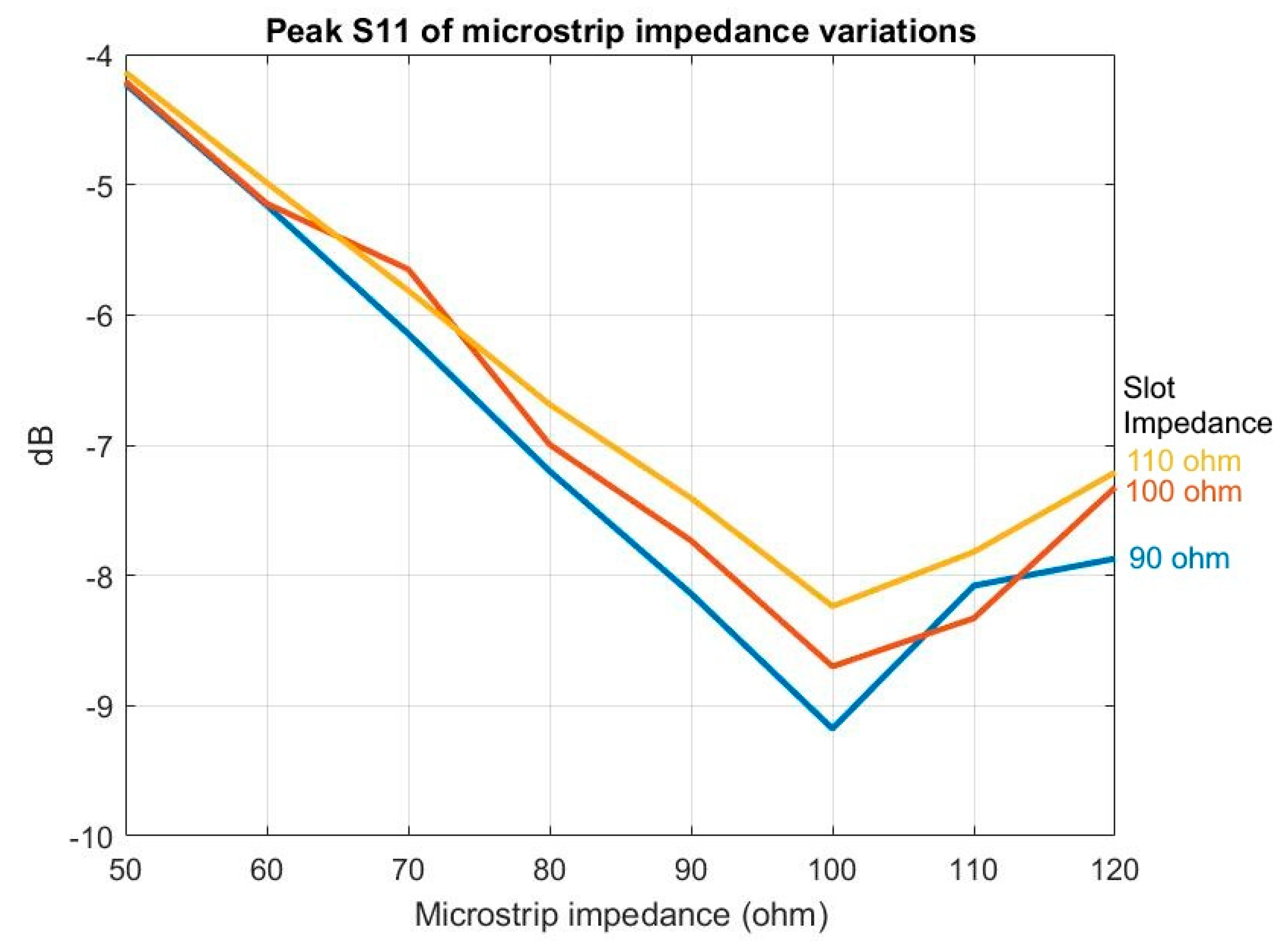

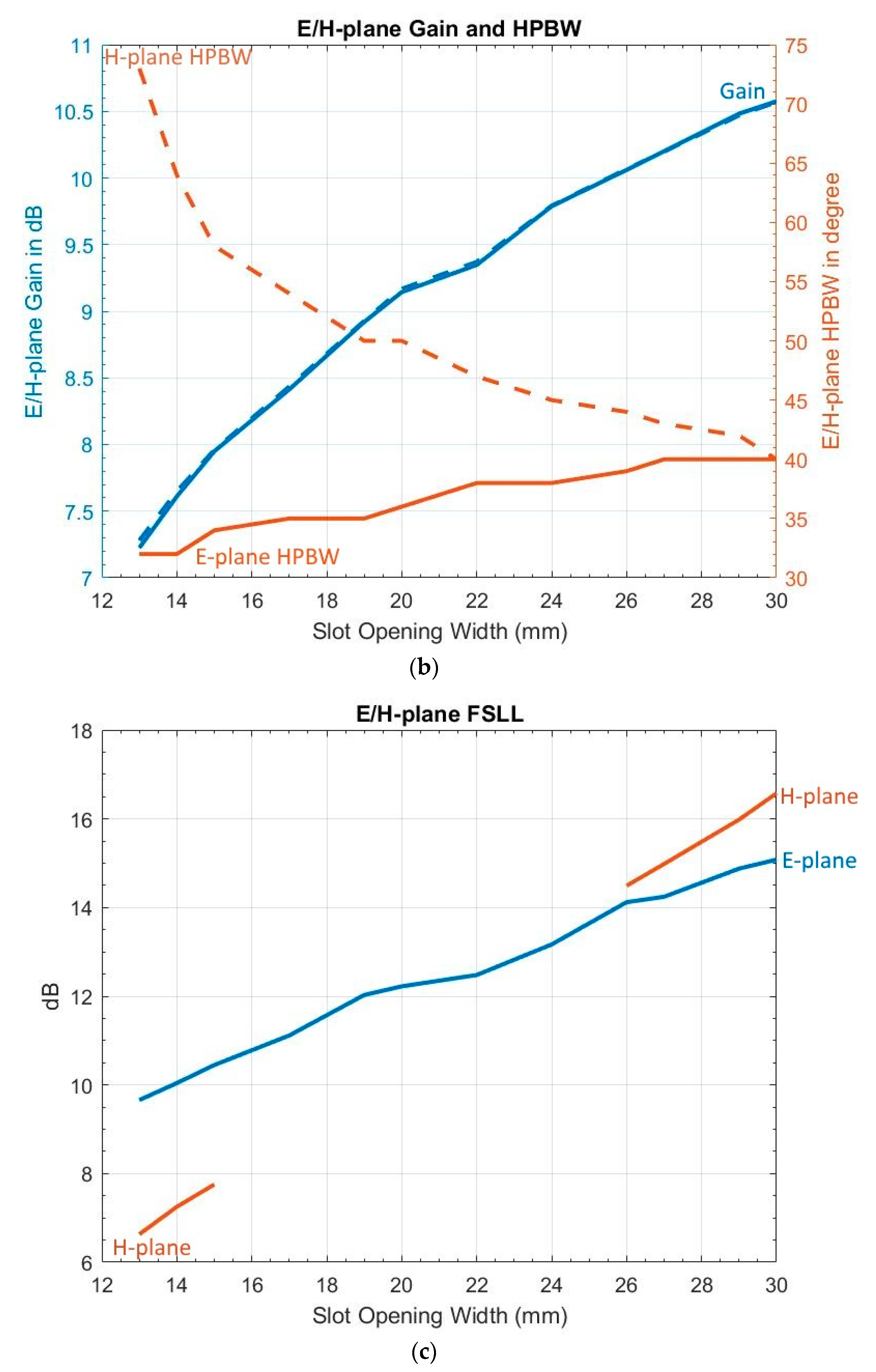
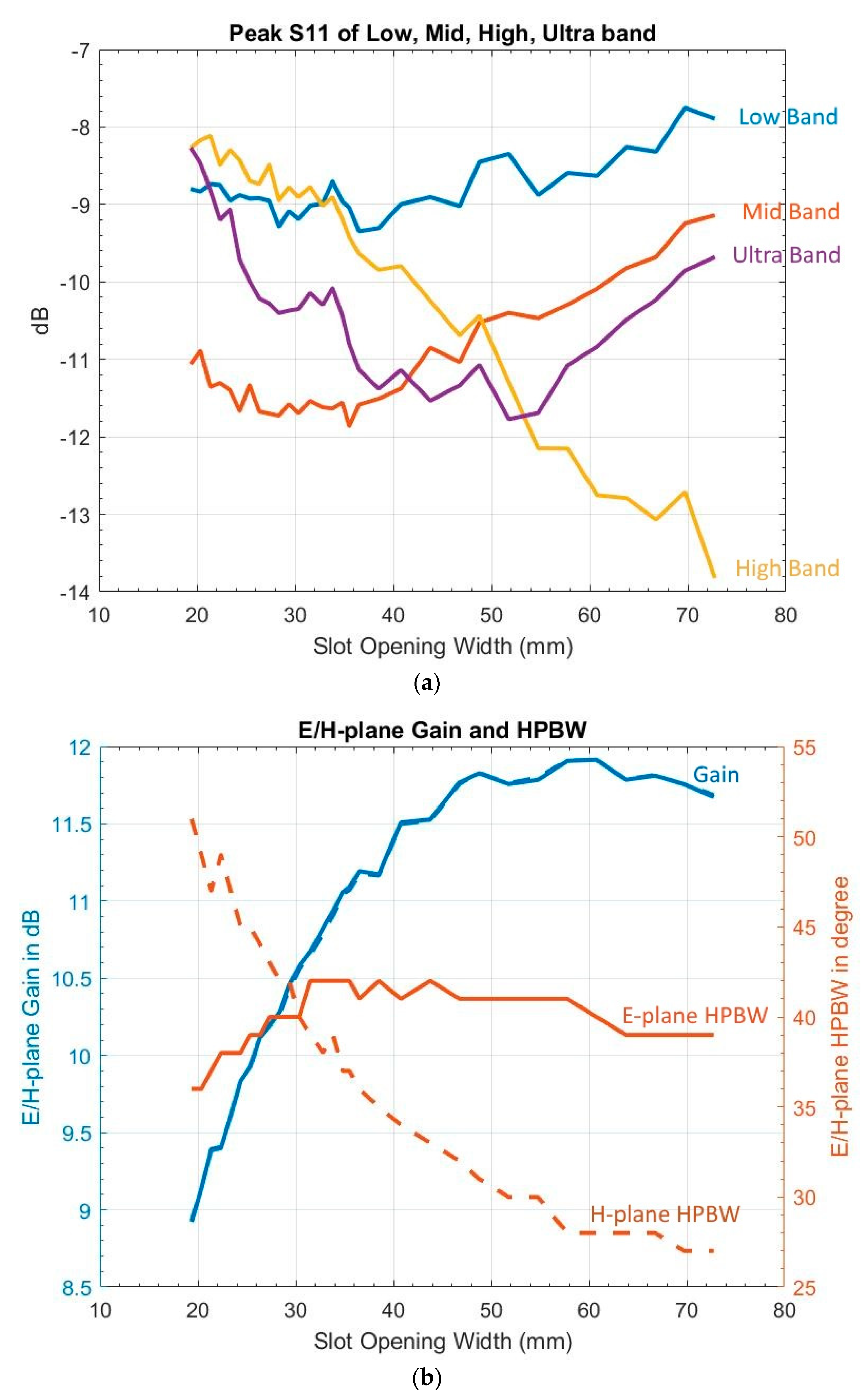

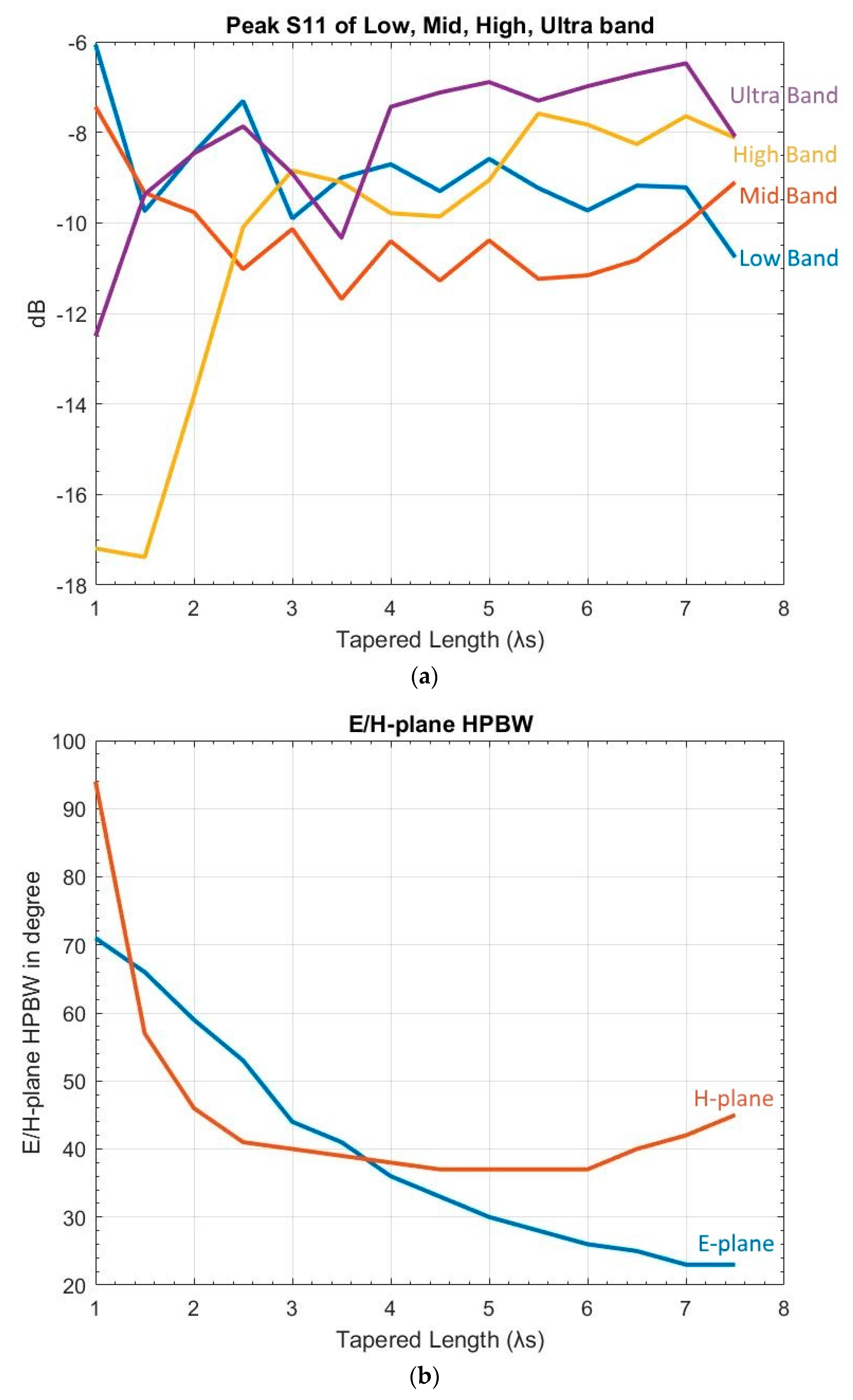
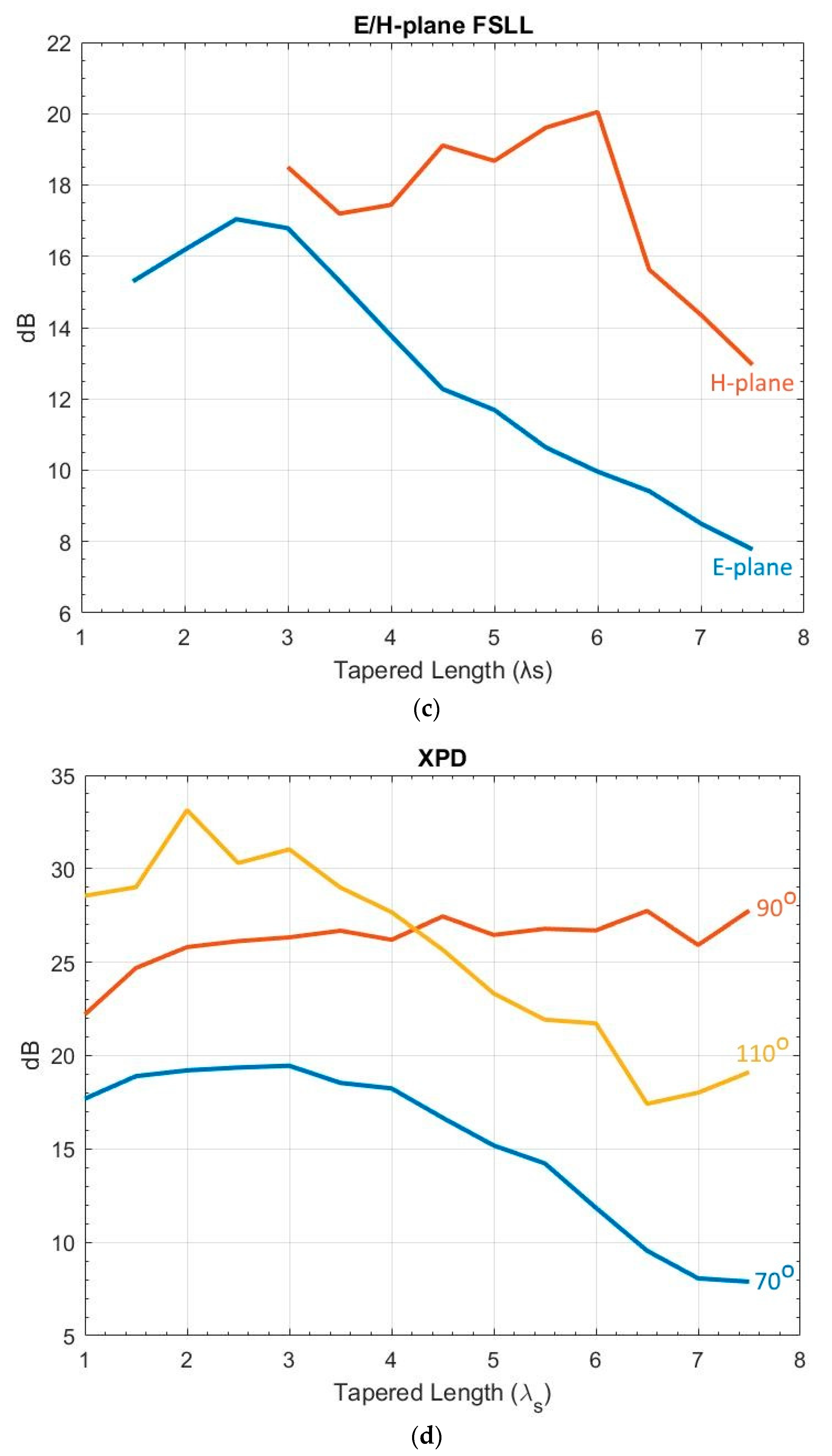

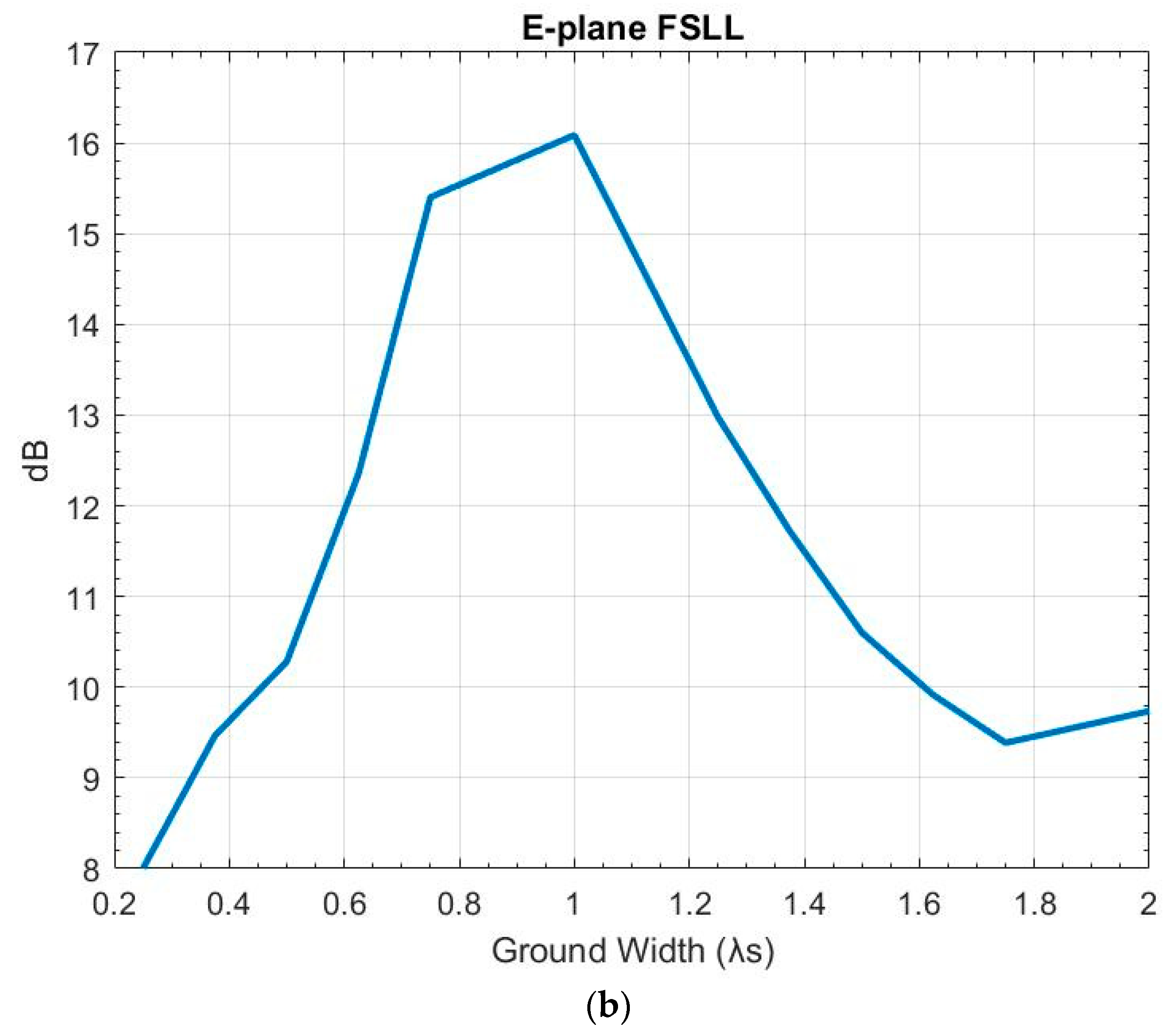
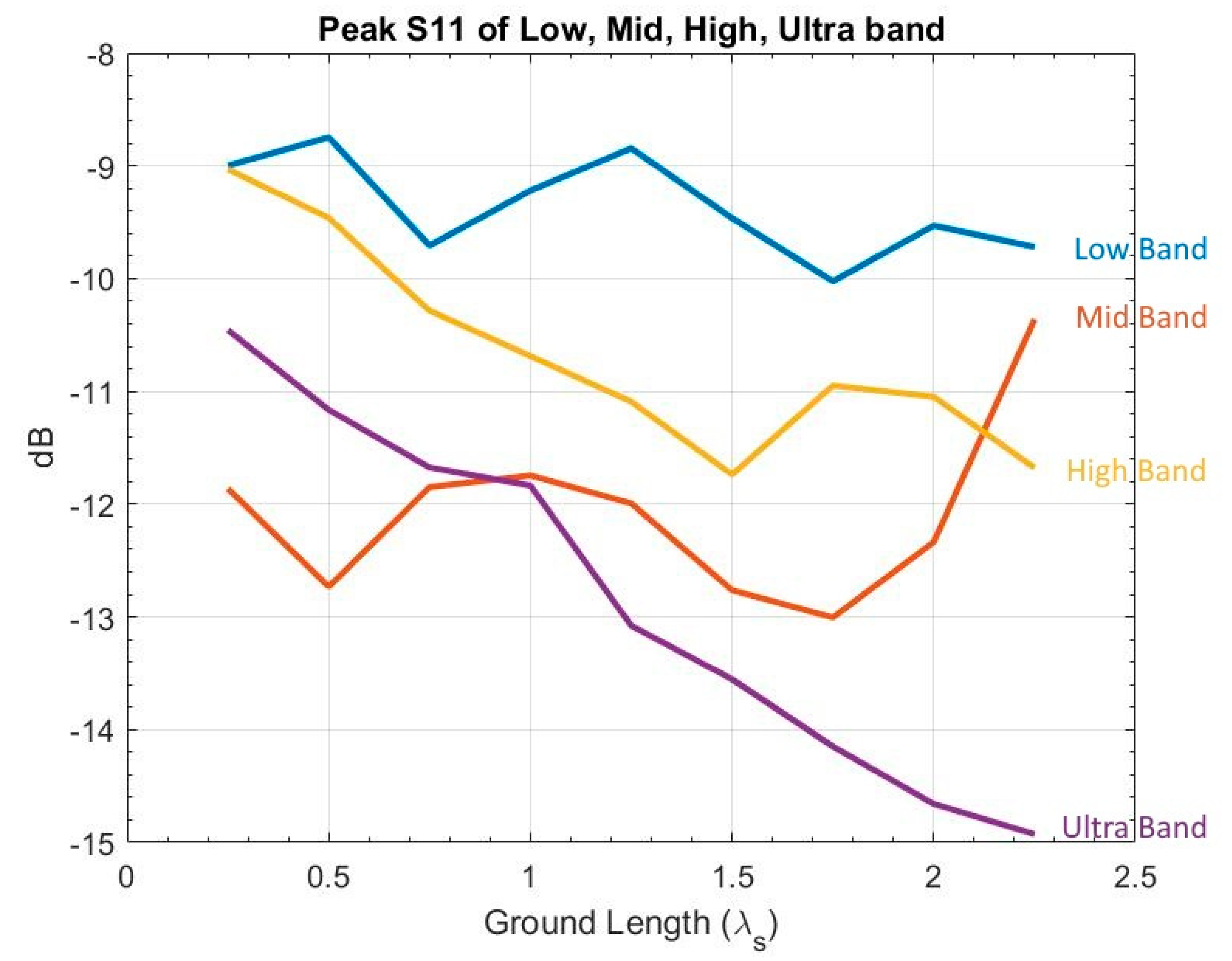

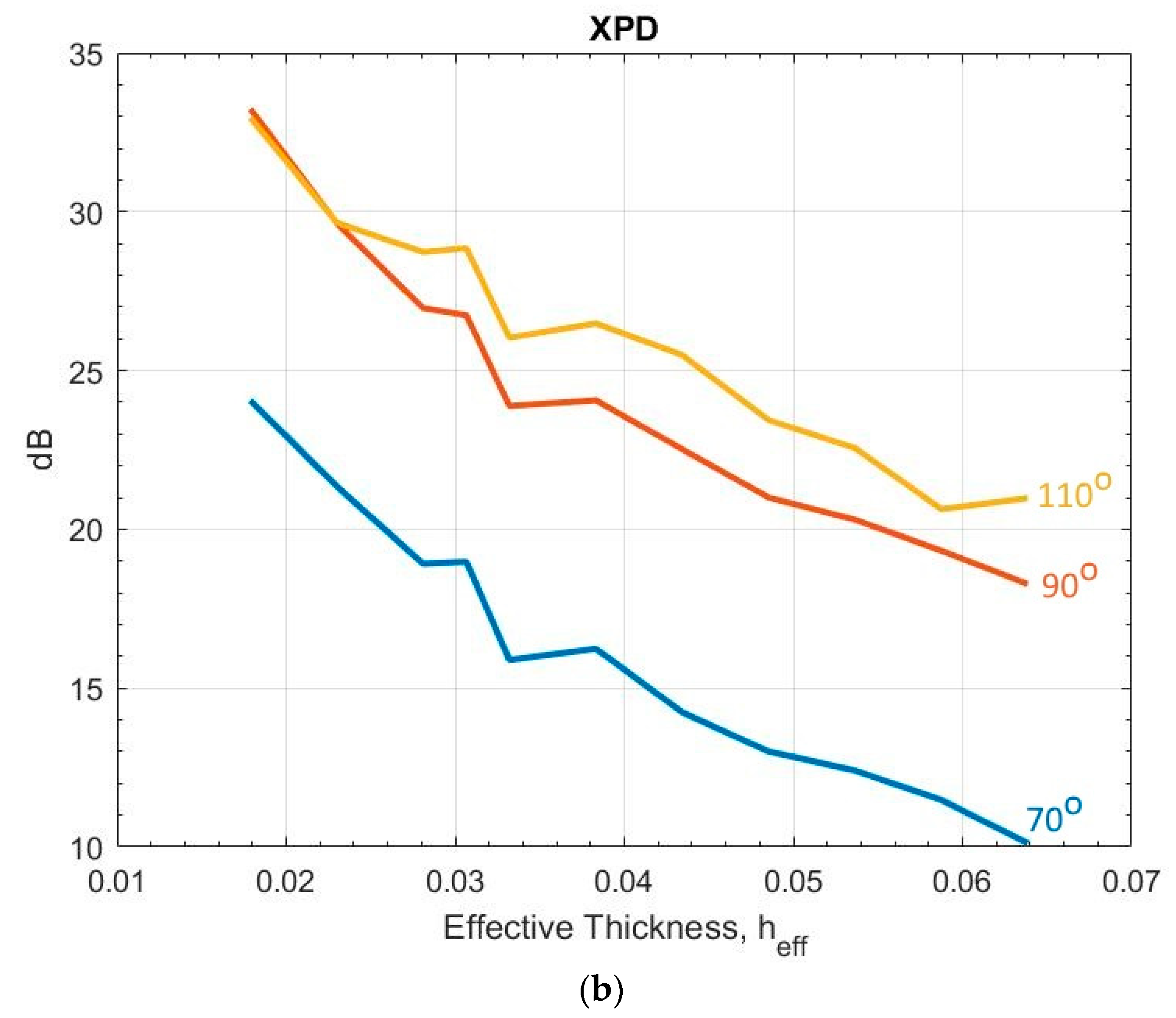
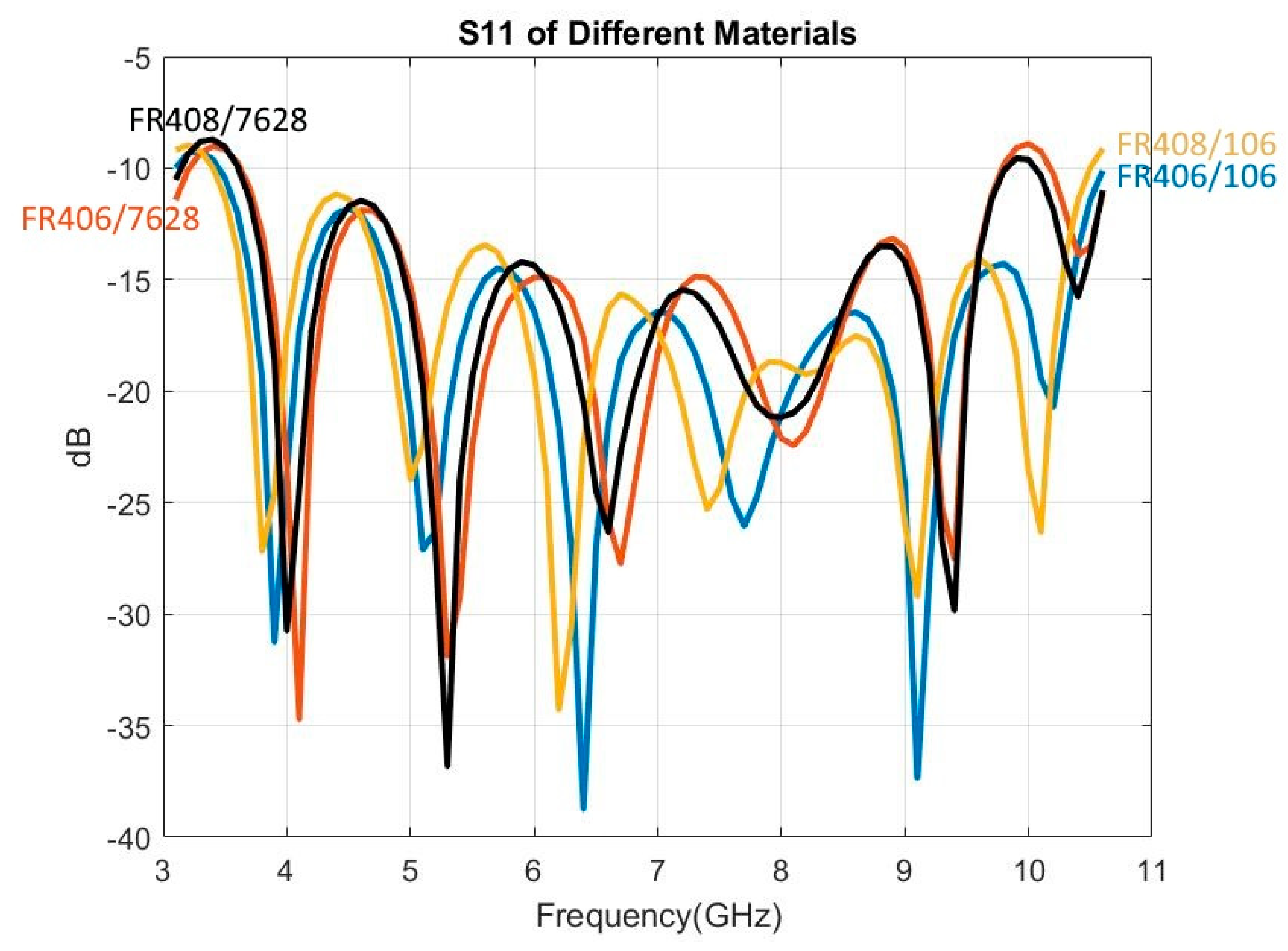
| Parameter | Setting | Notes |
|---|---|---|
| Slot width () | 0.178 mm | = minimum PCB manufacturer’s processing capability |
| Microstrip width () | 0.354 mm | = width that generated 100 Ω impedance |
| Slot stud radius () | 6.0386 mm | = , where is the wavelength of the center frequency when passing through the PCB material |
| Slot stud opening angle | 90 degrees | Fixed, not varied |
| Microstrip stud radius () | 7.0888 mm | = |
| Microstrip stud opening angle | 90 degrees | Fixed, not varied |
| Slot opening width () | 31.5056 mm | = |
| Tapered length () | 110.2695 mm | = |
| Ground width () | 23.6292 mm | = |
| Ground length () | 7.8764 mm | = |
| Substrate thickness () | 30 mil | |
| Substrate material | FR406 Type 7628 | FR4 PCB material manufactured by Isola Corporation |
| −10.34 | −9.38 | −9.80 | −9.20 | −8.95 | −8.90 | −8.66 | −8.32 | −8.30 | −8.19 | −8.08 | ||
| −10.23 | −9.80 | −9.56 | −9.29 | −6.82 | −8.76 | −8.70 | −8.50 | −8.06 | −8.30 | −8.30 | ||
| −10.00 | −9.20 | −9.23 | −9.27 | −9.22 | −8.87 | −9.76 | −7.96 | −8.43 | −8.35 | −8.32 | ||
| −9.77 | −8.08 | −9.33 | −9.18 | −9.17 | −8.84 | −10.21 | −8.71 | −8.00 | −7.59 | −7.90 | ||
| −9.59 | −9.40 | −9.49 | −9.15 | −8.96 | −8.66 | −8.61 | −8.60 | −8.48 | −8.32 | −8.21 | ||
| −9.33 | −9.44 | −9.35 | −9.15 | −9.10 | −8.80 | −8.20 | −8.66 | −8.66 | −8.48 | −8.44 | ||
| −9.18 | −9.20 | −9.30 | −9.08 | −8.96 | −7.72 | −8.72 | −8.70 | −8.51 | −8.51 | −7.90 | ||
| −7.43 | −9.15 | −9.26 | −8.70 | −9.08 | −8.74 | −8.77 | −8.67 | −7.68 | −8.59 | −6.90 | ||
| −7.74 | −7.98 | −7.90 | −8.10 | −8.02 | −8.36 | −8.57 | −7.95 | −8.63 | −8.34 | −8.01 | ||
| −6.24 | −5.36 | −6.54 | −7.20 | −7.41 | −7.53 | −8.00 | −8.39 | −8.74 | −8.11 | −8.00 | ||
| −4.48 | −4.42 | −5.14 | −5.51 | −5.90 | −6.31 | −5.64 | −6.82 | −6.72 | −6.05 | −6.24 | ||
| Material | tanδ at 5 MHz | |
|---|---|---|
| FR406 Type 106 | 3.39 | 0.023 |
| FR406 Type 7628 | 4.1 | 0.016 |
| FR408 Type 106 | 3.23 | 0.015 |
| FR408 Type 7628 | 3.94 | 0.011 |
| Para-Meter | Previous Studies | This Study | |
|---|---|---|---|
| Range Recommended | Examined Against Assessment Criteria of This Study | Range Recommended | |
| N/A | N/A | ||
| N/A | N/A | ||
| [18] or [28] | S11 passed at but failed at | ||
| Between and [17] | Failed at Passed beyond | between and | |
| [11] | —S11 failed —FSLL failed | ||
| N/A | N/A | ||
| N/A | N/A | or | |
| between 0.005 and 0.03 [11] or between 0.005 and 0.01 [8] | Pass | ||
| FR4 Material | N/A | N/A | Negligible impact |
© 2019 by the authors. Licensee MDPI, Basel, Switzerland. This article is an open access article distributed under the terms and conditions of the Creative Commons Attribution (CC BY) license (http://creativecommons.org/licenses/by/4.0/).
Share and Cite
Tseng, V.; Chang, C.-Y. Linear Tapered Slot Antenna for Ultra-Wideband Radar Sensor: Design Consideration and Recommendation. Sensors 2019, 19, 1212. https://doi.org/10.3390/s19051212
Tseng V, Chang C-Y. Linear Tapered Slot Antenna for Ultra-Wideband Radar Sensor: Design Consideration and Recommendation. Sensors. 2019; 19(5):1212. https://doi.org/10.3390/s19051212
Chicago/Turabian StyleTseng, Vincent, and Cheng-Yuan Chang. 2019. "Linear Tapered Slot Antenna for Ultra-Wideband Radar Sensor: Design Consideration and Recommendation" Sensors 19, no. 5: 1212. https://doi.org/10.3390/s19051212






